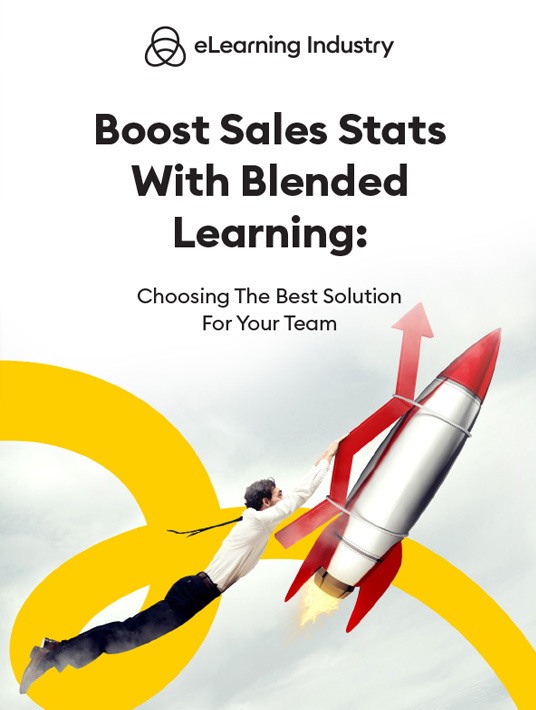Blended Learning Examples To Improve Employee Engagement Scores
Online learning is lauded for its convenience, affordability, and flexibility. Offline learning offers a sense of camaraderie and the human touch. Either option on its own has downsides, but when you merge them in the right combination, you get optimal results. So, what are some actionable techniques you can apply to enhance the efficiency of blended training? Let’s look at some prime blended learning examples to improve employee engagement using your new blended learning LMS.

5 Blended Learning Examples To Increase Employee Engagement
1. ILT Sessions Followed By Social Media Discussions
Ordinarily, a blended learning program will have online lessons that get summarized with in-person discussions. So, you might study five days on your own and then have classroom sessions on the weekend or even at the end of the month. Because they’re so few and far apart, classroom sessions will often cram a lot of material into a small period. Instructors can issue handouts or slideshows that trainees will study on their own. Then they can have formal discussions on closed social media groups to parse content further. These discussions can be moderated by the instructor, just to keep everyone on task. Plus, the instructor will notice any passive trainees and gently draw them out with targeted questions. It shouldn’t be done in a pushy format. Rather, the instructor can ask the “quiet” trainee specific inquiries to draw out their expertise. It makes them feel seen, valued, and therefore engaged.
2. Live Events Paired With Follow-Up Simulations That Impart Real-World Experience
This is similar to the example above, except instead of a class, it’s more social. A class may have a teacher lecturing as trainees sit and listen. An event could have multiple speakers who don’t directly engage individuals. Instead of lectures, they could give speeches or multimedia presentations. They demonstrate relevant skills and tasks. There could also be a series of smaller stands for each speaker, and trainees circulate around the booths. Or even webinars that cover different aspects of the subject. Later, L&D can pick out specific tasks from the event and design simulations. These virtual exercises invite trainees to practice the skills they observed at the event. Simulations are also a helpful way to take said skills and couch them in a more true-to-life way. For example, an event demo may have explained Google Maps. A simulation can get trainees to apply mapping skills to help them find a safer, cheaper commuting route or direct a customer to a nearby branch. This process can be further improved by including employee engagement software to track participation and gather feedback.
3. Giving Employees Access To A JIT Library So They Bridge Gaps Autonomously
Asking for help is sometimes seen as a sign of weakness. This could be a product of childhood experiences or the result of office politics and corporate sabotage. Either way, it’s a crucial balance. You want to enable employees to retain their sense of competence—both in themselves and in the eyes of colleagues. But you don’t want to sacrifice corporate errors at the feet of pride. JIT libraries are a good way to solve both. Unlike a fleshed-out lesson, JIT blended learning LMS resources focus on the exact task. When you need a refresher in parallel parking, it won’t waste your time with car parts and product labels. It will give you a quick plan of direct steps you can follow. And it will put them in clear, easily absorbed language because you only have a few minutes. They’re specifically designed for fast consumption and application because they’re often employed when seconds are all you have.
4. Branching Scenarios That Involve Offline Components
Decision-making is a key skill, especially cause-and-effect. Branching scenarios help you make tough choices under pressure. But they show you the consequences of those selections too. This trains you to always think three or four steps ahead, even for the smallest workplace decision. With blended learning software, scenarios can be presented in simple text messages or detailed animation. Add some realism by having some of those scenarios bring trainees offline. For example, they’re presented with a dilemma and asked to choose Door A or Door B. Behind the digital door, have an instruction to go offline. Say they were asked to venture into the electronics or housewares department. They must physically head to their chosen location to look for the product in question or address a customer’s needs. It’s good exercise, engages adrenaline, and ups their investment in the course. It’s also more fun and they’re likely to remember the material better, thanks to environmental (and physical) cues.
5. Flipped Classroom Session Based On Virtual Pre-Assignments
In most school scenarios, students listen to a lecture, take notes, then review them at home. One of the top blended learning examples reverses the model. Send trainees their notes and study material ahead of time. Have them go through the content and list any questions. During the classroom session, give them the reins. They can ask anything that’s unclear or explain concepts to their colleagues. It’s a bit like a book report, but more in-depth and with additional interaction.
Conclusion
In theory, a blended learning LMS is a blessing to your budget. But it can be just as wasteful as any other form of training unless you do it right. So, what are some practical tips you can apply to get the most out of your blended training program? Have the instructor lead a class, then orchestrate further discussions on social media. Invite trainees to live events and build simulations around what they see and hear at said events. Provide a comprehensive JIT library, and design branching scenarios that jump from online to off and back. Send learning materials to your trainees by email. Then set a date to come together and discuss the material in class.
It all starts with a realistic budget, a plan of action, and the right compliance training LMS. An online directory is a great place to vet your top options and choose a system that falls within your budget.
You can also download the eBook Boost Sales Stats With Blended Learning: Choosing The Best Solution For Your Team to discover which blended learning LMS is a wise investment for your organization.








